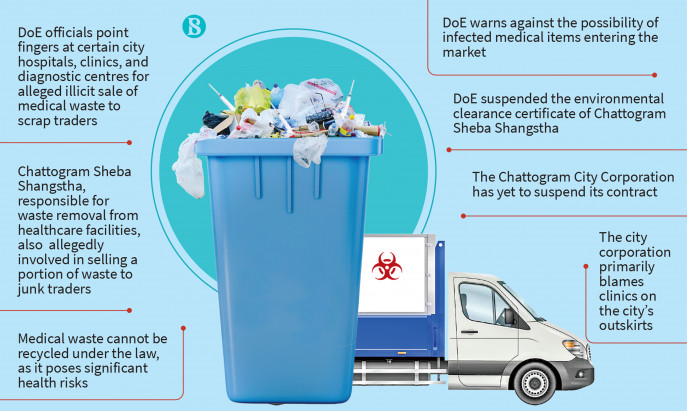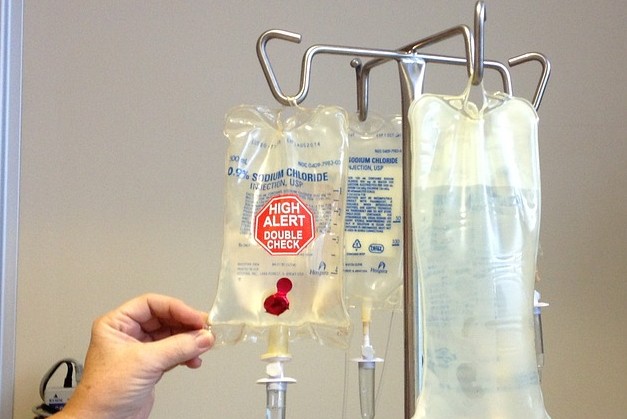Proactive Health Solutions: Choosing the very best Medical Waste Removal Near You
Proactive Health Solutions: Choosing the very best Medical Waste Removal Near You
Blog Article
Keep Ahead of Laws: Professional Recommendations on Medical Garbage Disposal
In a globe where the healthcare industry is continuously advancing, it is essential for clinical centers to stay ahead of guidelines when it comes to the correct disposal of clinical waste. From understanding the different groups of clinical waste to executing the best collection and segregation methods, this discussion will give useful understandings and actionable pointers to assist centers stay ahead of regulations in the ever-changing landscape of clinical waste disposal.
Comprehending Medical Waste Categories
Comprehending clinical waste classifications is vital for proper disposal and management in health care facilities. Medical waste refers to any kind of waste generated by healthcare activities that might present a hazard to public wellness or the environment. It is crucial to classify clinical waste accurately to ensure its risk-free handling, disposal, transport, and treatment.
There are numerous classifications of clinical waste that medical care facilities require to be accustomed to. One of the most common classifications consist of infectious waste, pathological waste, sharps waste, pharmaceutical waste, and chemical waste. Each category has particular standards and regulations for its appropriate monitoring and disposal.
Infectious waste includes materials contaminated with blood or various other physical liquids, such as handwear covers, dress, and research laboratory societies. Pathological waste refers to human tissues, organs, or body components that call for special delivery and disposal. Sharps waste consists of utilized needles, syringes, and other sharp items that can create injury and transmit infections. Pharmaceutical waste comprises run out, extra, or contaminated drugs that require cautious handling and disposal. Chemical waste includes solvents, anti-bacterials, and various other chemical substances used in healthcare facilities.
Staying Up-To-Date With Regulatory Adjustments
Staying current with regulative changes is important for health care centers to ensure conformity and correct administration of medical waste disposal. medical waste removal. With regulations continuously progressing, it is essential for health care centers to stay up-to-date to avoid charges, penalties, and prospective injury to the atmosphere and public wellness
To remain in advance of regulative modifications, healthcare facilities need to develop a system for monitoring and monitoring updates. This can be done by subscribing to regulative e-newsletters, going to workshops and meetings, and actively joining industry associations. Additionally, centers must designate a team member or group in charge of remaining educated and sharing information to relevant stakeholders.
Normal communication with regulative agencies is additionally important. Healthcare centers should establish relationships with local, state, and government companies to guarantee they know any adjustments in laws that might impact their waste management techniques. This can be done via routine meetings, participation in public remark periods, and proactive involvement with regulative companies.
Additionally, healthcare centers must take into consideration partnering with waste monitoring companies that specialize in clinical garbage disposal (medical waste disposal services with WasteX). These companies are frequently skilled in the latest policies and can supply advice and assistance to ensure compliance
Executing Proper Collection and Segregation Techniques
To properly handle clinical garbage disposal, health care centers must develop correct collection and partition approaches according to governing guidelines. Carrying out these approaches guarantees the safe handling and disposal of possibly hazardous materials, safeguards the setting, and reduces the threat of injuries and infections to health care employees and the basic public.
Appropriate collection and partition methods entail making use of marked containers and classifying systems. Medical care facilities need to offer plainly identified containers for different kinds of clinical waste, such as sharps, transmittable waste, pharmaceutical waste, and non-hazardous waste. These containers must be color-coded and plainly significant to avoid complication and promote easy recognition.
Furthermore, health care facilities should educate their staff on the proper treatments for gathering and setting apart medical waste. This includes informing them on the different kinds of waste, the proper containers to utilize, and the significance of following guidelines and guidelines. Regular training sessions and correspondence course should read more be performed to make certain that personnel stay updated on best techniques.
Furthermore, medical care facilities need to develop a system for regular collection and disposal of clinical waste. This might involve partnering with certified waste administration business that specialize in clinical waste disposal. These companies will certainly make certain that the gathered waste is delivered and gotten rid of in compliance with regulative requirements.
Picking the Right Disposal Methods

Incineration is one of one of the most common and reliable techniques for throwing away certain types of clinical waste, such as pathological waste and sharps. It entails the regulated combustion of waste at heats, lowering it to ash. Nonetheless, incineration can launch dangerous contaminants into the air and add to air pollution.

Chemical treatment entails the use of chemicals to disinfect and counteract the waste. Microwave therapy uses microwave power to heat and disinfect the waste.
Making Sure Compliance With Documentation and Training
After very carefully taking into consideration the suitable disposal approaches for medical waste, health care facilities must make sure compliance with regulations and decrease ecological influence by carrying out effective paperwork and training treatments. This step is essential in maintaining a risk-free and sustainable environment for both health care employees and the public.

Health care workers who manage medical waste must obtain proper training on waste segregation, dealing with, and disposal procedures. By giving comprehensive training, health care facilities can encourage their staff to make enlightened choices and reduce the danger of inappropriate waste disposal.
Conclusion
In final thought, staying in advance of policies in medical waste disposal is crucial for healthcare facilities. medical waste removal services. Comprehending the different classifications of clinical waste, staying upgraded with regulatory changes, carrying out appropriate collection and partition techniques, selecting the suitable disposal approaches, and ensuring conformity with paperwork and training are all essential steps. By following these standards, medical care companies can properly get rid of and handle of clinical waste in a liable and safe manner
From comprehending the different categories of clinical waste to carrying out the ideal collection and partition approaches, this discussion will certainly give valuable insights and workable tips to assist centers stay ahead of laws in the ever-changing landscape of medical waste disposal. - medical waste disposal services with WasteX
The most typical classifications consist of transmittable waste, pathological waste, sharps waste, pharmaceutical waste, and chemical waste. Medical care facilities should provide clearly labeled containers for different kinds of medical waste, such as sharps, contagious waste, pharmaceutical waste, and non-hazardous waste. Medical care centers need to develop an extensive system to tape-record and track all aspects of clinical waste disposal, including types of waste generated, quantities, and disposal methods utilized. Health care workers that take care of clinical waste needs to get proper training on waste segregation, dealing with, and disposal treatments.
Report this page